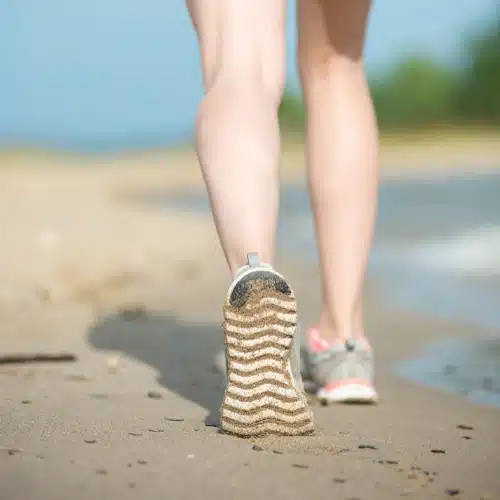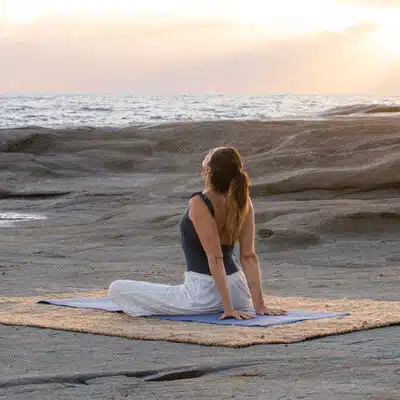Our bodies are wonderful things. Not only do they keep us moving through the busyness of everyday life, they rise to the occasion when it’s time to get active and exercise too. From running, swimming and cycling through to yoga, pilates or team sports, there are plenty of ways to get your heart rate up, work up a sweat and enjoy the endorphin rush that comes from exercise.
And while our bodies are designed to keep up, it’s important that we take the right amount of care and caution to prevent muscle fatigue and avoid strain – or even serious injury. From preventative stretches and warm-ups, to therapeutic treatments and cool downs, muscle mindfulness is vital to making sure you keep them in the best possible condition.
These are some of the ways you can nurture your body before, during and after exercise, to help you avoid fatigued muscles and succumbing to injury. So that you always feel rested and ready to dive into whatever activity or exercise is going to give you the joy of movement.

what causes muscle fatigue (and how can I spot it)?
Like every other living organism, we’re made up of countless cells – including muscle cells. Every time we exercise, no matter how long or how strenuous that exercise may be, we increase our muscle metabolism (in short, the biochemical balance of our muscle cells). As time passes or exercise becomes more intense, that balance becomes more and more impacted – which can ultimately lead to muscle fatigue.
Fatigue usually feels like you’re running out of steam and is noticeable when movements that felt easy enough at the start of a workout feel a little tougher to carry through. Your legs might feel heavier on a jog, or you might have more trouble holding a position on a reformer, for example.
This weakening of your muscles is the first sign that fatigue is setting in – and an important sign to ease up or, at the very least, be more mindful. For some of us, that weakness will set in a little sooner (the more our muscles get used to exercise, the longer it takes for fatigue to hit) – but ultimately, it all leads to the same place. Soreness, cramps, even injury if we’re not careful.
The good news? There are all sorts of things you can do to better equip your body for exercise, get more out of your workout before fatigue sets in – and avoid turning sore muscles into a more serious injury.
how can I reduce the risk of injury?
There are a number of ways you can get your body in the best possible condition for exercise – and provide the right amount of after-care to avoid injury or lasting soreness.
The first thing you should do before any exercise is warm up. It might only take 5 or 10 minutes, but it’s a great way to get yourself ready to raise your heart rate and work up a sweat. You might combine some light cardio exercise (a walk, a light jog or similar) with some dynamic stretching. Using a peanut roller or cylinder-shaped roller are easy tools to include in your warm-up that stretch out your muscle fibres to get you primed for exercise.

When you’re active, it’s important to stay mindful of your body and how it’s moving too. Pay attention to your form and keep an eye out for any signs of muscle fatigue or weakness. Slowing down your pace, taking some time-out or reducing weights in these moments can mean avoiding more serious strain.
And once you’re done, take the time to complete a proper cool down too. Stretch it out, breathe deeply to keep blood flow circulating – and then take the time to rest. You’ll be helping to reduce a build-up of lactic acid, which can lead to muscular pain like DOMS (delayed onset muscle soreness).
what are some of the ways I can help my body recover from muscle soreness and fatigue?
Muscle fatigue isn’t necessarily a bad thing, or a sign that you’ve pushed yourself to the point of injury. It is, however, a sign that you’ve done enough – and you should be taking steps to give your body some care and therapy before getting back out there.
have a massage
There are all kinds of ways you can relieve sore muscles after exercise. A deep tissue targeted massage is one of the most effective – as our therapists can provide exactly the right kind of muscular therapy to aid your recovery and bring relief to the areas that are feeling the most fatigue.
home remedies
You can keep treating muscle soreness with a range of at-home remedies as well. A trigger point ball, for instance, can provide deeper, targeted relief to localised muscle groups that might be feeling some pain. Having a heat pack or pillow on hand also means having ready access to some soothing, gentle relief. Made with wheat – and often infused with other soothing ingredients like revitalising lemon myrtle or relaxing lavender, they can be used hot or cold to take away some of the tension you might be carrying in your muscles.
use products with natural ingredients
Nature offers us an abundance of ingredients that work wonderfully for relieving sore and tired muscles, many of which can be added to a warm bath or massaged directly into your skin. Magnesium is widely-known as one of the most effective of these – a mineral with some remarkably soothing qualities. You’ll find it in our Magnesium Mist, as well as our Mint & Macadamia Recovery Bath. Arnica is another natural ingredient that enriches a number of these restorative treatments. It’s a healing herb that can reduce bruising, muscle pain and stiffness – making it a vital part of products like our Arnica and Menthol Recovery Scrub.
And if it’s the invigorating, refreshing and soothing quality of menthol and peppermint that your body’s calling out for, look no further than our Clove & Mint Recovery Balm. It’s reached cult-like status for a reason – providing a naturally-uplifting recovery remedy that you can gently massage into tired muscles.
our bodies are at their best when we give them the proper care
Whether you prefer high-intensity exercise, or just the day-to-day activity that comes with a busy life, we ask a lot of our bodies. So it’s important to give them the rest and recovery they deserve too. So take the right steps when you’re exercising – from warming up and cooling down, to staying mindful of your form and when your muscles start to fatigue. And, of course, treating sore muscles to a massage or at-home treatment.
Doing so will help you avoid injury. So that you can keep enjoying all of the benefits of an active lifestyle – however you decide to keep your body moving.


